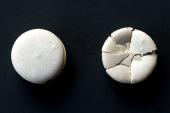Crushed Prasugrel in the Ambulance Ups Platelet Inhibition in Primary PCI
Increased PRUs, however, were not linked to better ST-segment resolution, leaving opportunities open for new agents.

Original findings of COMPARE CRUSH, presented last year during TCT 2020, showed no improvement in reperfusion rates following administration of a crushed prasugrel loading dose, despite earlier indications from CRUSH and MOJITO that this might be the case.
However, despite the disappointing results from the overall trial, the current prespecified analysis definitively shows improvements in platelet inhibition after crushing. “There is no drawback, there is no risk in [crushing prasugrel] and there might be clinical benefits,” senior author Georgios J. Vlachojannis, MD, PhD (University Medical Center Utrecht, the Netherlands), told TCTMD. “If the treating physician has a feeling that he has to achieve faster platelet inhibition and that the patient would benefit from this, this is the way to go.”
For the study, published in the June 28, 2021, issue of JACC: Cardiovascular Interventions, Rosanne F. Vogel, MD (University Medical Center Utrecht), along with Vlachojannis and colleagues included 441 patients with suspected STEMI from COMPARE CRUSH who were randomized to crushed or integral prasugrel 60-mg loading dose in the ambulance. Pharmacodynamic measurements were taken before treatment, at the beginning and end of primary PCI, and 4 hours after treatment.
High platelet reactivity at the end of primary PCI (primary endpoint) was nearly halved in the group who received crushed compared with whole prasugrel (34.7% vs 61.6%; OR 0.33; 95% CI 0.22-0.50).
Interestingly, those with low platelet reactivity (< 150 PRUs) at the beginning of coronary angiography saw improved TIMI flow grade 3 in the infarct-related artery before primary PCI (OR 1.78; 95% CI 1.08-2.94; P = 0.02). However, low platelet reactivity did not lead to ST-segment resolution (OR 0.80; 95% CI 0.48-1.34; P = 0.40).
The overall MACCE rate was 4.7% within the first 30 days. Four patients (0.6%) reported acute or subacute stent thrombosis, and both of the two classified as “definite” stent thrombosis had high platelet reactivity.
“This is to our knowledge the largest analysis in this acute phase of STEMI from first medical contact to PCI and for 4 hours after treatment on the pharmacodynamics of prasugrel,” Vlachojannis said. “It's the first time we report this on such a scale: that these crushed tables of prasugrel loading dose reduced the rate of patients with this high platelet reactivity by almost 50% as measured at start of PCI. This is a strong finding that crushing tablets of prasugrel in the acute phase really works on such a high level.”
Bridging the Gap
“These observations underscore the need for agents with more prompt and potent antiplatelet effects such as cangrelor or glycoprotein inhibitors, which are able overcome the gap in platelet inhibition attributed to oral P2Y12 inhibitors,” the authors write. “Whether earlier and more potent platelet inhibition can additionally facilitate optimal myocardial reperfusion in patients undergoing primary PCI is still not clear, with only scarce evidence that timely application of glycoprotein inhibitors has the potential to influence early coronary reperfusion and clinical outcomes in STEMI.”
At this point, “administration of crushed ticagrelor or prasugrel in place of integral tablets is logical, and earlier administration may lower the prevalence of high platelet reactivity,” write Arka Chatterjee, MD, and Kristina Skinner, DO (both from University of Arizona College of Medicine, Tucson), in an accompanying editorial. However, they note the median time from first medical contact to primary PCI in this trial was 79 minutes, whereas this is usually much longer in US clinical practice.
“Although using a crushed formulation in patients who can get primary PCI rapidly, as done in trial populations, may not yield a clinical benefit, it is possible it may have an amplified role in patients getting transferred for primary PCI,” the editorialists continue. “This would be supported by the finding of increased spontaneous recanalization of the culprit vessel and TIMI flow grade 3 if optimal platelet reactivity levels were achieved in the COMPARE-CRUSH population.”
Vlachojannis said he is excited about upcoming results of the CELEBRATE trial looking at the novel agent RUC-4 (CeleCor Therapeutics), which is injected subcutaneously in the ambulance and can potentially close the treatment gap that’s present with current oral platelet inhibitors. “It will be interesting to see if we can indeed get a better earlier reperfusion with this pharmacological agent,” he said.
Yael L. Maxwell is Senior Medical Journalist for TCTMD and Section Editor of TCTMD's Fellows Forum. She served as the inaugural…
Read Full BioSources
Vogel RF, Delewi R, Angiolillo DJ, et al. Pharmacodynamic effects of pre-hospital administered crushed prasugrel in patients with ST-segment elevation myocardial infarction. J Am Coll Cardiol Intv. 2021;14:1323-1333.
Chatterjee A, Skinner K. Crushed prasugrel improves pharmacodynamics but little else: where are the missing pieces? J Am Coll Cardiol Intv. 2021;14:1334-1336.
Disclosures
- The COMPARE CRUSH trial was funded by Maasstad Research B.V., which received unrestricted grants from Daiichi-Sankyo and Shanghai MicroPort Medical.
- Vlachojannis has received consulting fees from AstraZeneca; and research grant support from Daiichi-Sankyo and Shanghai MicroPort.
- Vogel, Chatterjee, and Skinner report no relevant conflicts of interest.




Comments